MSc International Business: Merrion Products Ltd. Case Study Solution
VerifiedAdded on 2023/02/01
|24
|7294
|67
Case Study
AI Summary
This case study analyzes the financial performance of Merrion Products Ltd., focusing on production planning and profitability. The analysis begins with calculating the contribution margin for each product (A, B, C, and D) to identify the most profitable option. It determines the most profitable production plan, considering raw material constraints and maximum sales units. The study calculates the break-even point, opportunity cost, and assesses the impact of a sales price increase. Detailed calculations are presented, including variable and fixed overhead allocation, cost of production, and profit and loss statements. The case study provides a comprehensive overview of financial management principles, demonstrating how to maximize profitability under resource limitations and market conditions. The study uses Excel to perform calculations and includes various tables and exhibits to support the findings.
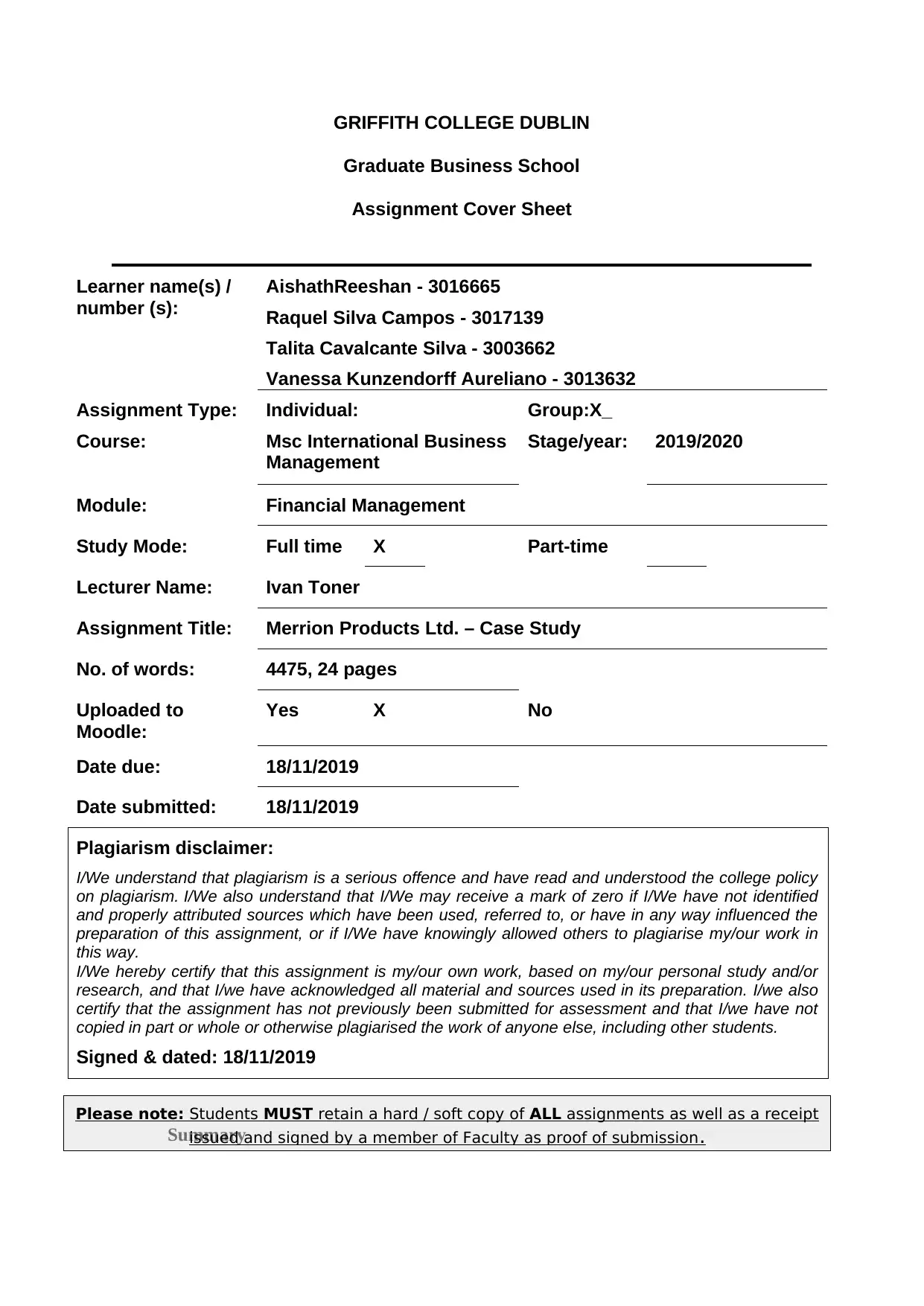
GRIFFITH COLLEGE DUBLIN
Graduate Business School
Assignment Cover Sheet
Learner name(s) /
number (s):
AishathReeshan - 3016665
Raquel Silva Campos - 3017139
Talita Cavalcante Silva - 3003662
Vanessa Kunzendorff Aureliano - 3013632
Assignment Type:
Course:
Individual:
Msc International Business
Management
Group:X_
Stage/year: 2019/2020
Module: Financial Management
Study Mode: Full time X Part-time
Lecturer Name: Ivan Toner
Assignment Title: Merrion Products Ltd. – Case Study
No. of words: 4475, 24 pages
Uploaded to
Moodle:
Yes X No
Date due: 18/11/2019
Date submitted: 18/11/2019
Plagiarism disclaimer:
I/We understand that plagiarism is a serious offence and have read and understood the college policy
on plagiarism. I/We also understand that I/We may receive a mark of zero if I/We have not identified
and properly attributed sources which have been used, referred to, or have in any way influenced the
preparation of this assignment, or if I/We have knowingly allowed others to plagiarise my/our work in
this way.
I/We hereby certify that this assignment is my/our own work, based on my/our personal study and/or
research, and that I/we have acknowledged all material and sources used in its preparation. I/we also
certify that the assignment has not previously been submitted for assessment and that I/we have not
copied in part or whole or otherwise plagiarised the work of anyone else, including other students.
Signed & dated: 18/11/2019
Summary
Please note: Students MUST retain a hard / soft copy of ALL assignments as well as a receipt
issued and signed by a member of Faculty as proof of submission.
Graduate Business School
Assignment Cover Sheet
Learner name(s) /
number (s):
AishathReeshan - 3016665
Raquel Silva Campos - 3017139
Talita Cavalcante Silva - 3003662
Vanessa Kunzendorff Aureliano - 3013632
Assignment Type:
Course:
Individual:
Msc International Business
Management
Group:X_
Stage/year: 2019/2020
Module: Financial Management
Study Mode: Full time X Part-time
Lecturer Name: Ivan Toner
Assignment Title: Merrion Products Ltd. – Case Study
No. of words: 4475, 24 pages
Uploaded to
Moodle:
Yes X No
Date due: 18/11/2019
Date submitted: 18/11/2019
Plagiarism disclaimer:
I/We understand that plagiarism is a serious offence and have read and understood the college policy
on plagiarism. I/We also understand that I/We may receive a mark of zero if I/We have not identified
and properly attributed sources which have been used, referred to, or have in any way influenced the
preparation of this assignment, or if I/We have knowingly allowed others to plagiarise my/our work in
this way.
I/We hereby certify that this assignment is my/our own work, based on my/our personal study and/or
research, and that I/we have acknowledged all material and sources used in its preparation. I/we also
certify that the assignment has not previously been submitted for assessment and that I/we have not
copied in part or whole or otherwise plagiarised the work of anyone else, including other students.
Signed & dated: 18/11/2019
Summary
Please note: Students MUST retain a hard / soft copy of ALL assignments as well as a receipt
issued and signed by a member of Faculty as proof of submission.
Paraphrase This Document
Need a fresh take? Get an instant paraphrase of this document with our AI Paraphraser
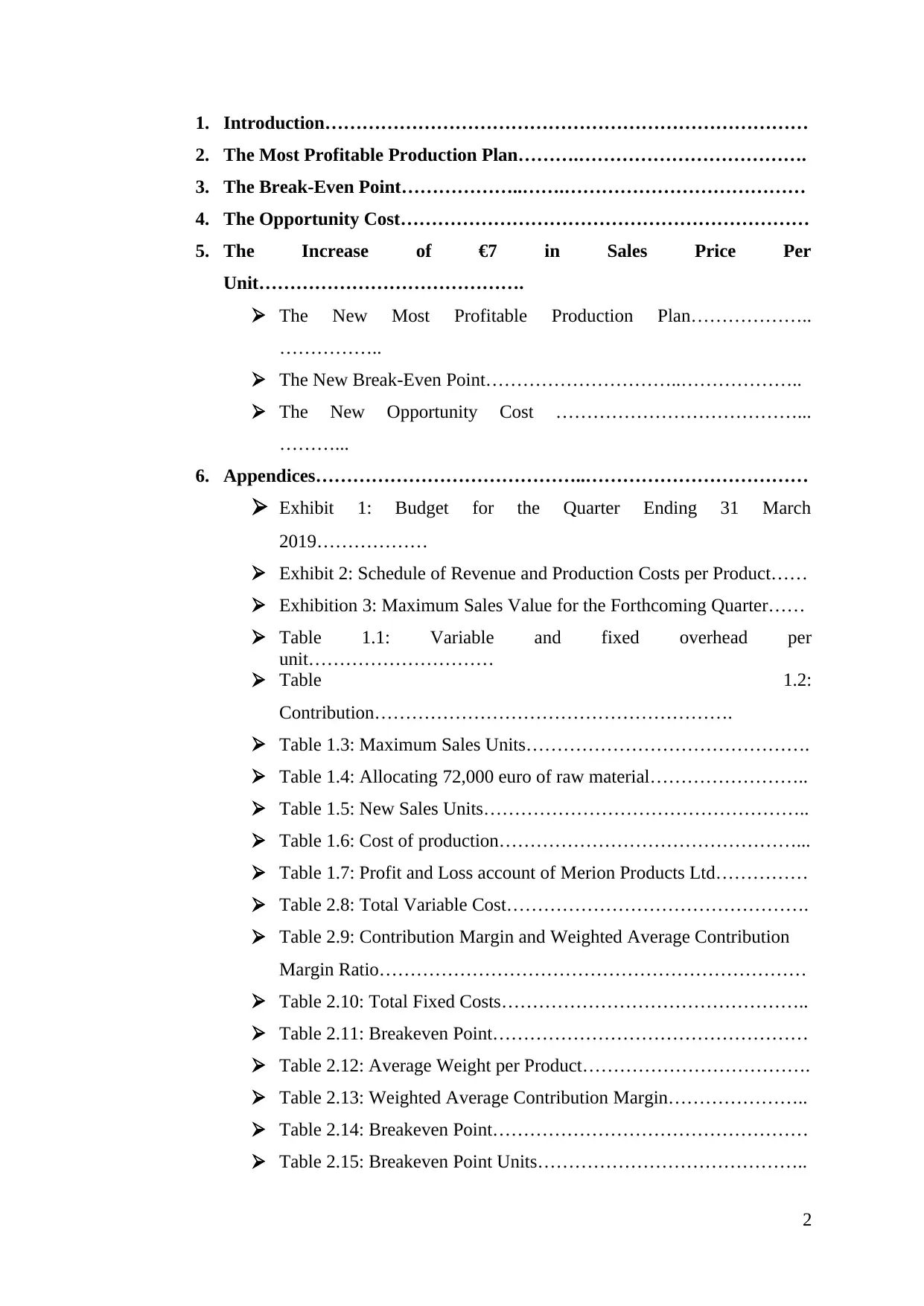
1. Introduction……………………………………………………………………
2. The Most Profitable Production Plan……….……………………………….
3. The Break-Even Point………………..…….…………………………………
4. The Opportunity Cost…………………………………………………………
5. The Increase of €7 in Sales Price Per
Unit…………………………………….
The New Most Profitable Production Plan………………..
……………..
The New Break-Even Point…………………………..………………..
The New Opportunity Cost …………………………………...
………...
6. Appendices……………………………………..………………………………
Exhibit 1: Budget for the Quarter Ending 31 March
2019………………
Exhibit 2: Schedule of Revenue and Production Costs per Product……
Exhibition 3: Maximum Sales Value for the Forthcoming Quarter……
Table 1.1: Variable and fixed overhead per
unit…………………………
Table 1.2:
Contribution………………………………………………….
Table 1.3: Maximum Sales Units……………………………………….
Table 1.4: Allocating 72,000 euro of raw material……………………..
Table 1.5: New Sales Units……………………………………………..
Table 1.6: Cost of production…………………………………………...
Table 1.7: Profit and Loss account of Merion Products Ltd……………
Table 2.8: Total Variable Cost………………………………………….
Table 2.9: Contribution Margin and Weighted Average Contribution
Margin Ratio……………………………………………………………
Table 2.10: Total Fixed Costs…………………………………………..
Table 2.11: Breakeven Point……………………………………………
Table 2.12: Average Weight per Product……………………………….
Table 2.13: Weighted Average Contribution Margin…………………..
Table 2.14: Breakeven Point……………………………………………
Table 2.15: Breakeven Point Units……………………………………..
2
2. The Most Profitable Production Plan……….……………………………….
3. The Break-Even Point………………..…….…………………………………
4. The Opportunity Cost…………………………………………………………
5. The Increase of €7 in Sales Price Per
Unit…………………………………….
The New Most Profitable Production Plan………………..
……………..
The New Break-Even Point…………………………..………………..
The New Opportunity Cost …………………………………...
………...
6. Appendices……………………………………..………………………………
Exhibit 1: Budget for the Quarter Ending 31 March
2019………………
Exhibit 2: Schedule of Revenue and Production Costs per Product……
Exhibition 3: Maximum Sales Value for the Forthcoming Quarter……
Table 1.1: Variable and fixed overhead per
unit…………………………
Table 1.2:
Contribution………………………………………………….
Table 1.3: Maximum Sales Units……………………………………….
Table 1.4: Allocating 72,000 euro of raw material……………………..
Table 1.5: New Sales Units……………………………………………..
Table 1.6: Cost of production…………………………………………...
Table 1.7: Profit and Loss account of Merion Products Ltd……………
Table 2.8: Total Variable Cost………………………………………….
Table 2.9: Contribution Margin and Weighted Average Contribution
Margin Ratio……………………………………………………………
Table 2.10: Total Fixed Costs…………………………………………..
Table 2.11: Breakeven Point……………………………………………
Table 2.12: Average Weight per Product……………………………….
Table 2.13: Weighted Average Contribution Margin…………………..
Table 2.14: Breakeven Point……………………………………………
Table 2.15: Breakeven Point Units……………………………………..
2
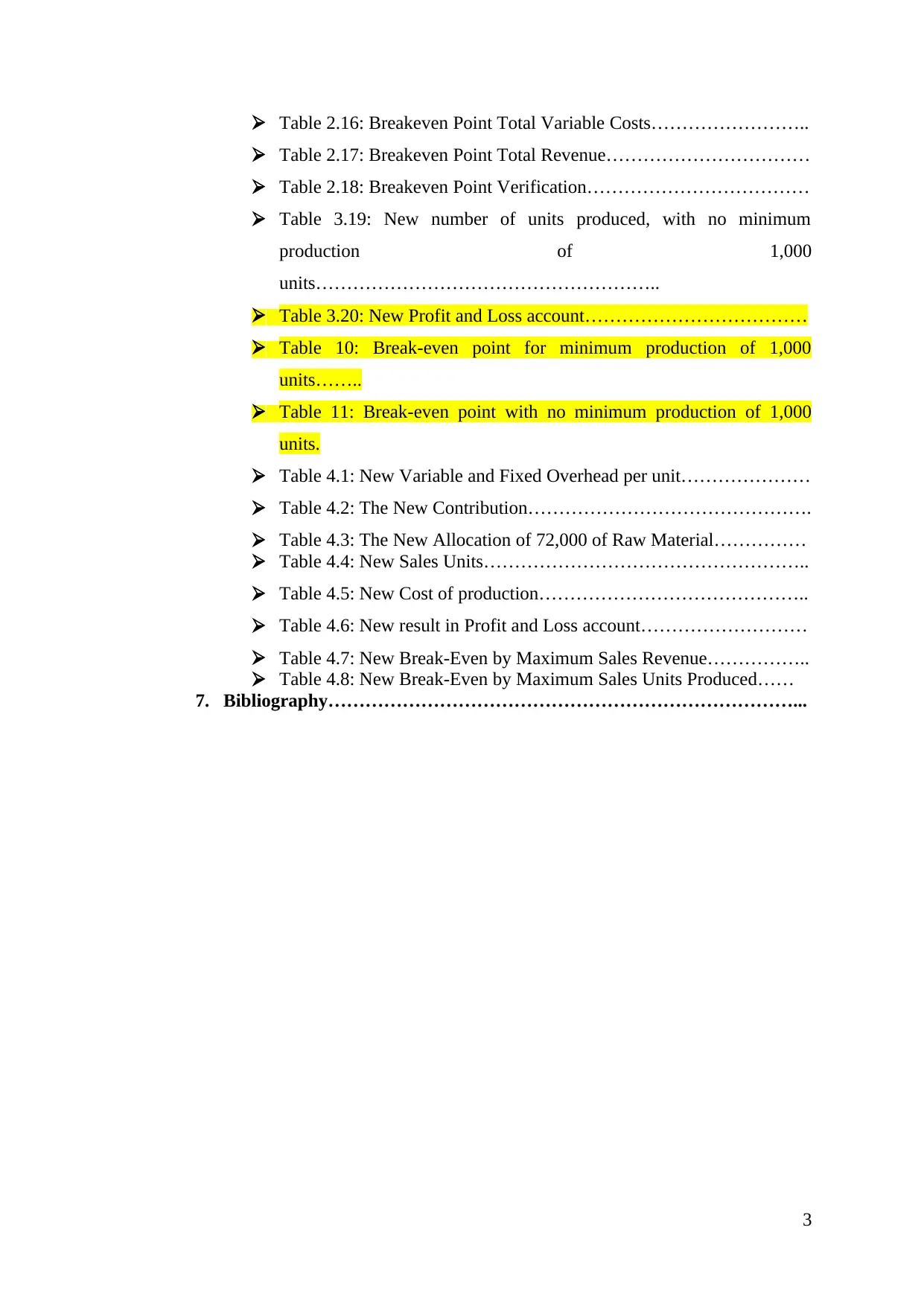
Table 2.16: Breakeven Point Total Variable Costs……………………..
Table 2.17: Breakeven Point Total Revenue……………………………
Table 2.18: Breakeven Point Verification………………………………
Table 3.19: New number of units produced, with no minimum
production of 1,000
units………………………………………………..
Table 3.20: New Profit and Loss account………………………………
Table 10: Break-even point for minimum production of 1,000
units……..
Table 11: Break-even point with no minimum production of 1,000
units.
Table 4.1: New Variable and Fixed Overhead per unit…………………
Table 4.2: The New Contribution……………………………………….
Table 4.3: The New Allocation of 72,000 of Raw Material……………
Table 4.4: New Sales Units……………………………………………..
Table 4.5: New Cost of production……………………………………..
Table 4.6: New result in Profit and Loss account………………………
Table 4.7: New Break-Even by Maximum Sales Revenue……………..
Table 4.8: New Break-Even by Maximum Sales Units Produced……
7. Bibliography…………………………………………………………………...
3
Table 2.17: Breakeven Point Total Revenue……………………………
Table 2.18: Breakeven Point Verification………………………………
Table 3.19: New number of units produced, with no minimum
production of 1,000
units………………………………………………..
Table 3.20: New Profit and Loss account………………………………
Table 10: Break-even point for minimum production of 1,000
units……..
Table 11: Break-even point with no minimum production of 1,000
units.
Table 4.1: New Variable and Fixed Overhead per unit…………………
Table 4.2: The New Contribution……………………………………….
Table 4.3: The New Allocation of 72,000 of Raw Material……………
Table 4.4: New Sales Units……………………………………………..
Table 4.5: New Cost of production……………………………………..
Table 4.6: New result in Profit and Loss account………………………
Table 4.7: New Break-Even by Maximum Sales Revenue……………..
Table 4.8: New Break-Even by Maximum Sales Units Produced……
7. Bibliography…………………………………………………………………...
3
⊘ This is a preview!⊘
Do you want full access?
Subscribe today to unlock all pages.

Trusted by 1+ million students worldwide
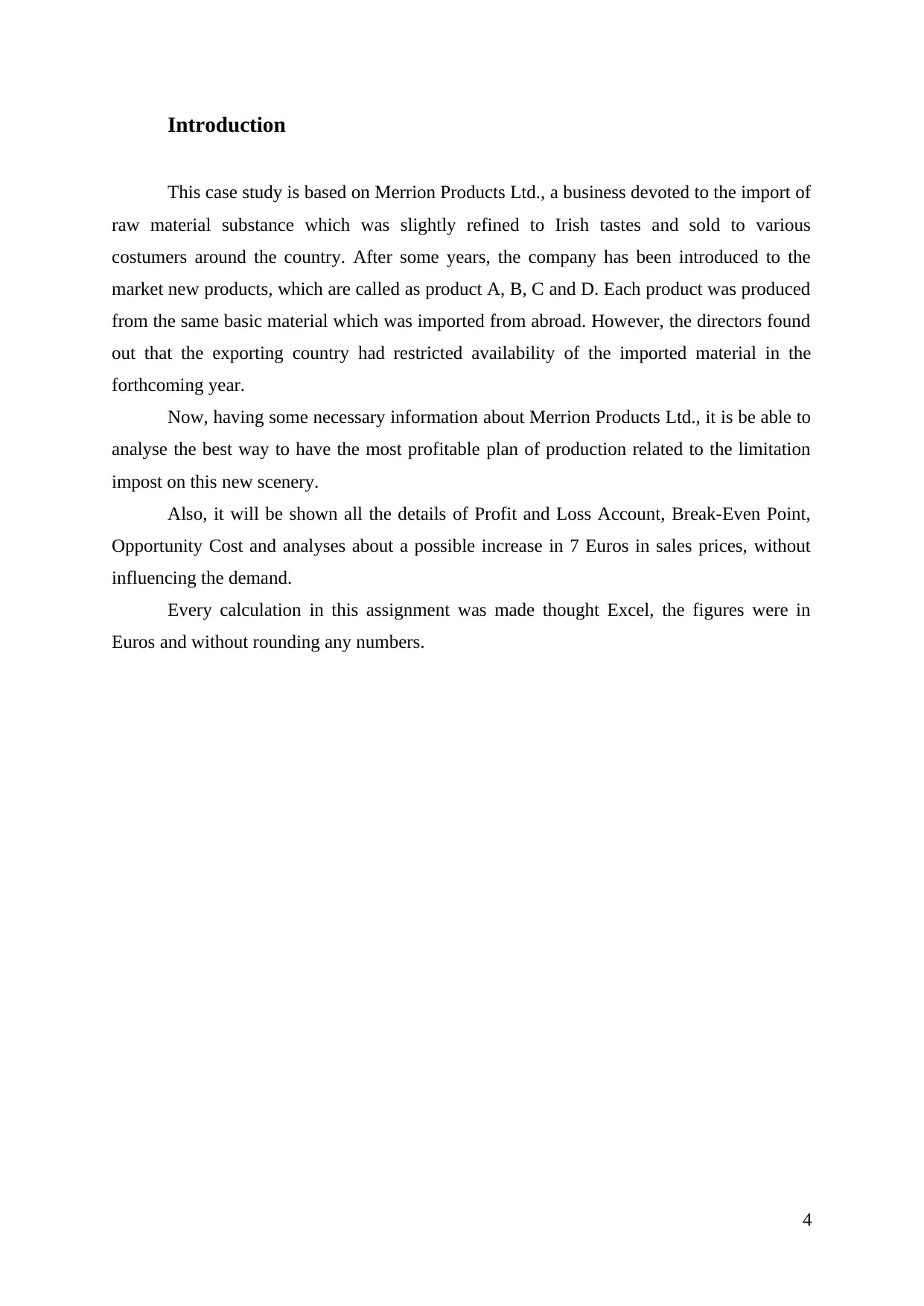
Introduction
This case study is based on Merrion Products Ltd., a business devoted to the import of
raw material substance which was slightly refined to Irish tastes and sold to various
costumers around the country. After some years, the company has been introduced to the
market new products, which are called as product A, B, C and D. Each product was produced
from the same basic material which was imported from abroad. However, the directors found
out that the exporting country had restricted availability of the imported material in the
forthcoming year.
Now, having some necessary information about Merrion Products Ltd., it is be able to
analyse the best way to have the most profitable plan of production related to the limitation
impost on this new scenery.
Also, it will be shown all the details of Profit and Loss Account, Break-Even Point,
Opportunity Cost and analyses about a possible increase in 7 Euros in sales prices, without
influencing the demand.
Every calculation in this assignment was made thought Excel, the figures were in
Euros and without rounding any numbers.
4
This case study is based on Merrion Products Ltd., a business devoted to the import of
raw material substance which was slightly refined to Irish tastes and sold to various
costumers around the country. After some years, the company has been introduced to the
market new products, which are called as product A, B, C and D. Each product was produced
from the same basic material which was imported from abroad. However, the directors found
out that the exporting country had restricted availability of the imported material in the
forthcoming year.
Now, having some necessary information about Merrion Products Ltd., it is be able to
analyse the best way to have the most profitable plan of production related to the limitation
impost on this new scenery.
Also, it will be shown all the details of Profit and Loss Account, Break-Even Point,
Opportunity Cost and analyses about a possible increase in 7 Euros in sales prices, without
influencing the demand.
Every calculation in this assignment was made thought Excel, the figures were in
Euros and without rounding any numbers.
4
Paraphrase This Document
Need a fresh take? Get an instant paraphrase of this document with our AI Paraphraser
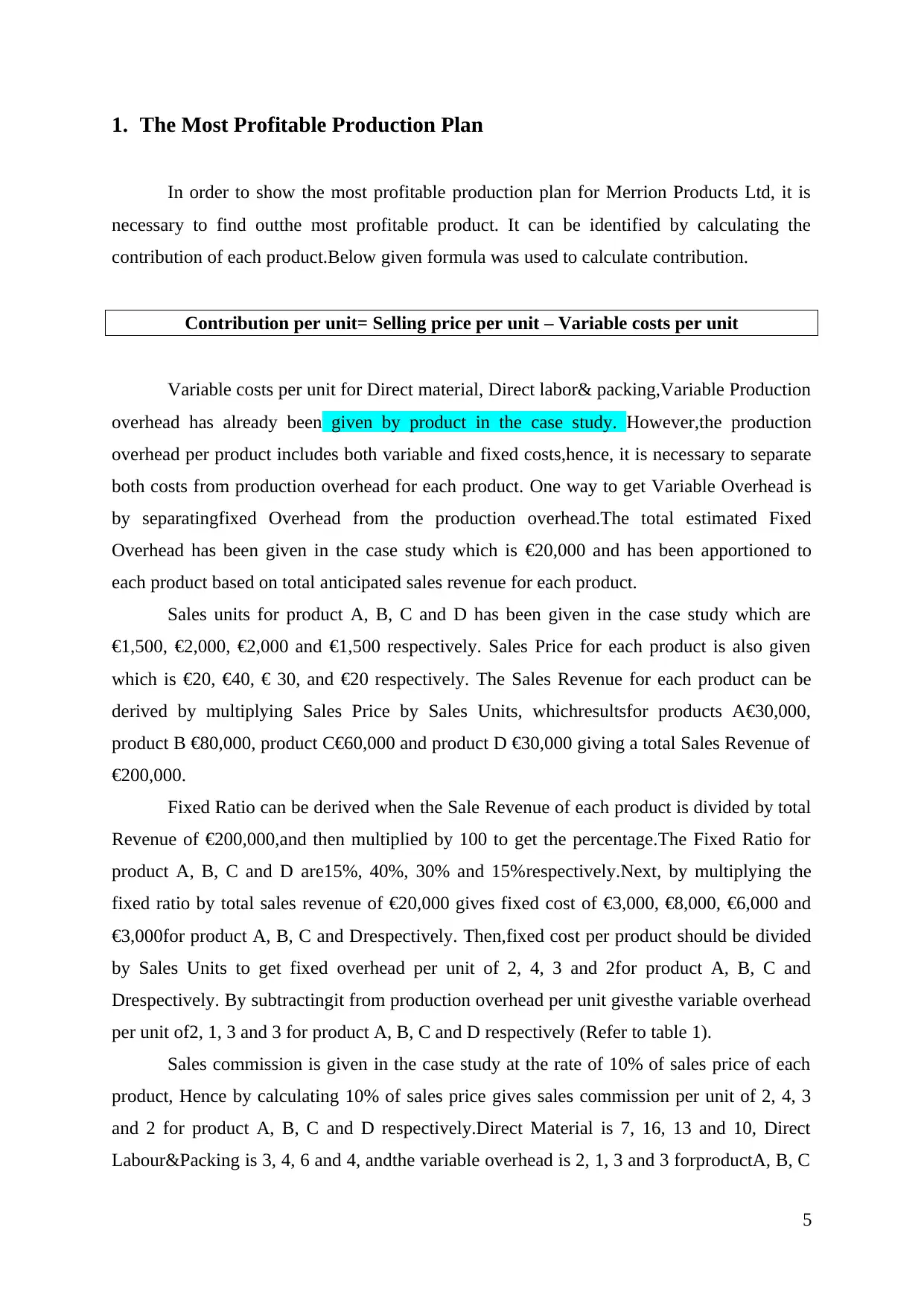
1. The Most Profitable Production Plan
In order to show the most profitable production plan for Merrion Products Ltd, it is
necessary to find outthe most profitable product. It can be identified by calculating the
contribution of each product.Below given formula was used to calculate contribution.
Contribution per unit= Selling price per unit – Variable costs per unit
Variable costs per unit for Direct material, Direct labor& packing,Variable Production
overhead has already been given by product in the case study. However,the production
overhead per product includes both variable and fixed costs,hence, it is necessary to separate
both costs from production overhead for each product. One way to get Variable Overhead is
by separatingfixed Overhead from the production overhead.The total estimated Fixed
Overhead has been given in the case study which is €20,000 and has been apportioned to
each product based on total anticipated sales revenue for each product.
Sales units for product A, B, C and D has been given in the case study which are
€1,500, €2,000, €2,000 and €1,500 respectively. Sales Price for each product is also given
which is €20, €40, € 30, and €20 respectively. The Sales Revenue for each product can be
derived by multiplying Sales Price by Sales Units, whichresultsfor products A€30,000,
product B €80,000, product C€60,000 and product D €30,000 giving a total Sales Revenue of
€200,000.
Fixed Ratio can be derived when the Sale Revenue of each product is divided by total
Revenue of €200,000,and then multiplied by 100 to get the percentage.The Fixed Ratio for
product A, B, C and D are15%, 40%, 30% and 15%respectively.Next, by multiplying the
fixed ratio by total sales revenue of €20,000 gives fixed cost of €3,000, €8,000, €6,000 and
€3,000for product A, B, C and Drespectively. Then,fixed cost per product should be divided
by Sales Units to get fixed overhead per unit of 2, 4, 3 and 2for product A, B, C and
Drespectively. By subtractingit from production overhead per unit givesthe variable overhead
per unit of2, 1, 3 and 3 for product A, B, C and D respectively (Refer to table 1).
Sales commission is given in the case study at the rate of 10% of sales price of each
product, Hence by calculating 10% of sales price gives sales commission per unit of 2, 4, 3
and 2 for product A, B, C and D respectively.Direct Material is 7, 16, 13 and 10, Direct
Labour&Packing is 3, 4, 6 and 4, andthe variable overhead is 2, 1, 3 and 3 forproductA, B, C
5
In order to show the most profitable production plan for Merrion Products Ltd, it is
necessary to find outthe most profitable product. It can be identified by calculating the
contribution of each product.Below given formula was used to calculate contribution.
Contribution per unit= Selling price per unit – Variable costs per unit
Variable costs per unit for Direct material, Direct labor& packing,Variable Production
overhead has already been given by product in the case study. However,the production
overhead per product includes both variable and fixed costs,hence, it is necessary to separate
both costs from production overhead for each product. One way to get Variable Overhead is
by separatingfixed Overhead from the production overhead.The total estimated Fixed
Overhead has been given in the case study which is €20,000 and has been apportioned to
each product based on total anticipated sales revenue for each product.
Sales units for product A, B, C and D has been given in the case study which are
€1,500, €2,000, €2,000 and €1,500 respectively. Sales Price for each product is also given
which is €20, €40, € 30, and €20 respectively. The Sales Revenue for each product can be
derived by multiplying Sales Price by Sales Units, whichresultsfor products A€30,000,
product B €80,000, product C€60,000 and product D €30,000 giving a total Sales Revenue of
€200,000.
Fixed Ratio can be derived when the Sale Revenue of each product is divided by total
Revenue of €200,000,and then multiplied by 100 to get the percentage.The Fixed Ratio for
product A, B, C and D are15%, 40%, 30% and 15%respectively.Next, by multiplying the
fixed ratio by total sales revenue of €20,000 gives fixed cost of €3,000, €8,000, €6,000 and
€3,000for product A, B, C and Drespectively. Then,fixed cost per product should be divided
by Sales Units to get fixed overhead per unit of 2, 4, 3 and 2for product A, B, C and
Drespectively. By subtractingit from production overhead per unit givesthe variable overhead
per unit of2, 1, 3 and 3 for product A, B, C and D respectively (Refer to table 1).
Sales commission is given in the case study at the rate of 10% of sales price of each
product, Hence by calculating 10% of sales price gives sales commission per unit of 2, 4, 3
and 2 for product A, B, C and D respectively.Direct Material is 7, 16, 13 and 10, Direct
Labour&Packing is 3, 4, 6 and 4, andthe variable overhead is 2, 1, 3 and 3 forproductA, B, C
5
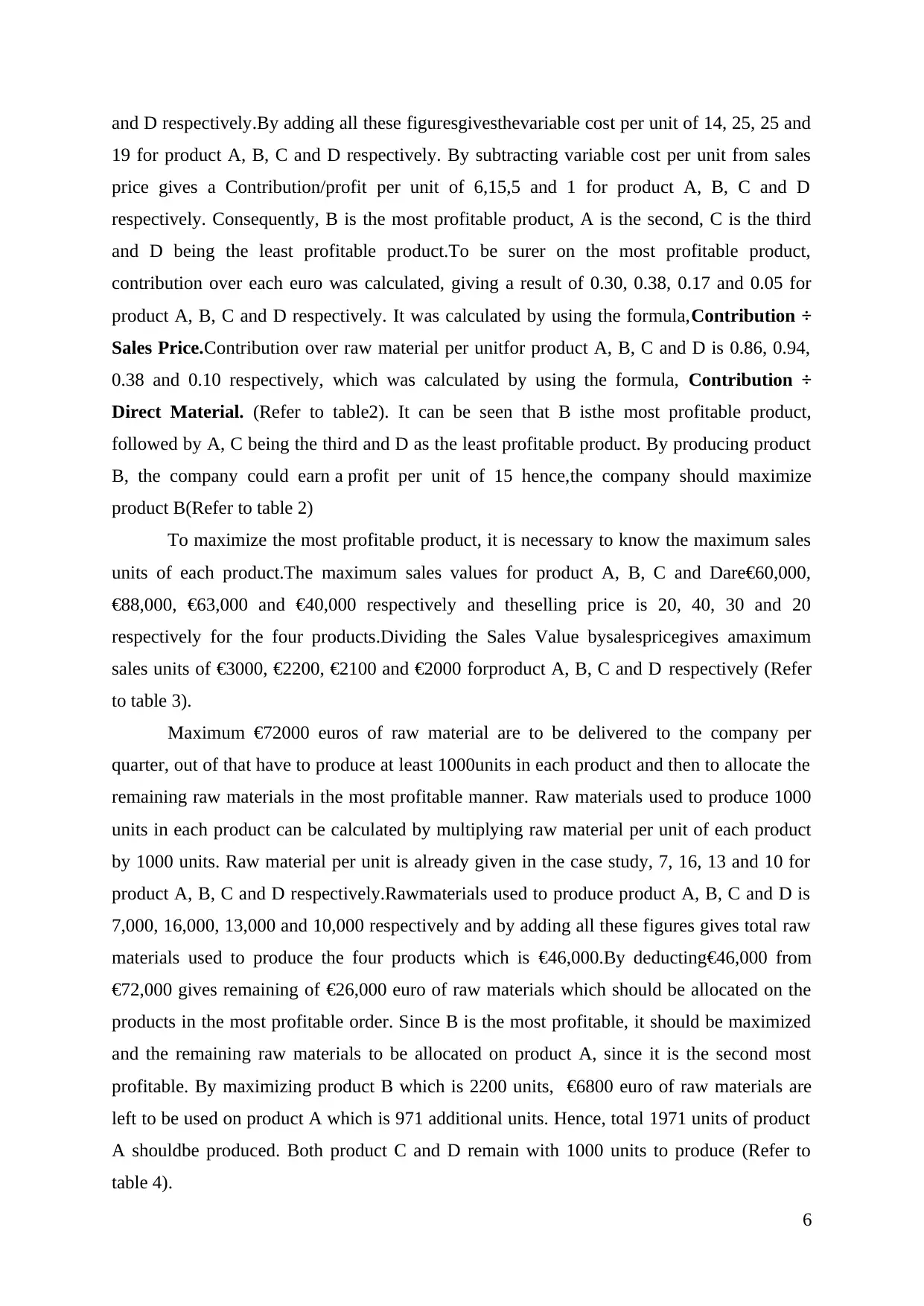
and D respectively.By adding all these figuresgivesthevariable cost per unit of 14, 25, 25 and
19 for product A, B, C and D respectively. By subtracting variable cost per unit from sales
price gives a Contribution/profit per unit of 6,15,5 and 1 for product A, B, C and D
respectively. Consequently, B is the most profitable product, A is the second, C is the third
and D being the least profitable product.To be surer on the most profitable product,
contribution over each euro was calculated, giving a result of 0.30, 0.38, 0.17 and 0.05 for
product A, B, C and D respectively. It was calculated by using the formula,Contribution ÷
Sales Price.Contribution over raw material per unitfor product A, B, C and D is 0.86, 0.94,
0.38 and 0.10 respectively, which was calculated by using the formula, Contribution ÷
Direct Material. (Refer to table2). It can be seen that B isthe most profitable product,
followed by A, C being the third and D as the least profitable product. By producing product
B, the company could earn a profit per unit of 15 hence,the company should maximize
product B(Refer to table 2)
To maximize the most profitable product, it is necessary to know the maximum sales
units of each product.The maximum sales values for product A, B, C and Dare€60,000,
€88,000, €63,000 and €40,000 respectively and theselling price is 20, 40, 30 and 20
respectively for the four products.Dividing the Sales Value bysalespricegives amaximum
sales units of €3000, €2200, €2100 and €2000 forproduct A, B, C and D respectively (Refer
to table 3).
Maximum €72000 euros of raw material are to be delivered to the company per
quarter, out of that have to produce at least 1000units in each product and then to allocate the
remaining raw materials in the most profitable manner. Raw materials used to produce 1000
units in each product can be calculated by multiplying raw material per unit of each product
by 1000 units. Raw material per unit is already given in the case study, 7, 16, 13 and 10 for
product A, B, C and D respectively.Rawmaterials used to produce product A, B, C and D is
7,000, 16,000, 13,000 and 10,000 respectively and by adding all these figures gives total raw
materials used to produce the four products which is €46,000.By deducting€46,000 from
€72,000 gives remaining of €26,000 euro of raw materials which should be allocated on the
products in the most profitable order. Since B is the most profitable, it should be maximized
and the remaining raw materials to be allocated on product A, since it is the second most
profitable. By maximizing product B which is 2200 units, €6800 euro of raw materials are
left to be used on product A which is 971 additional units. Hence, total 1971 units of product
A shouldbe produced. Both product C and D remain with 1000 units to produce (Refer to
table 4).
6
19 for product A, B, C and D respectively. By subtracting variable cost per unit from sales
price gives a Contribution/profit per unit of 6,15,5 and 1 for product A, B, C and D
respectively. Consequently, B is the most profitable product, A is the second, C is the third
and D being the least profitable product.To be surer on the most profitable product,
contribution over each euro was calculated, giving a result of 0.30, 0.38, 0.17 and 0.05 for
product A, B, C and D respectively. It was calculated by using the formula,Contribution ÷
Sales Price.Contribution over raw material per unitfor product A, B, C and D is 0.86, 0.94,
0.38 and 0.10 respectively, which was calculated by using the formula, Contribution ÷
Direct Material. (Refer to table2). It can be seen that B isthe most profitable product,
followed by A, C being the third and D as the least profitable product. By producing product
B, the company could earn a profit per unit of 15 hence,the company should maximize
product B(Refer to table 2)
To maximize the most profitable product, it is necessary to know the maximum sales
units of each product.The maximum sales values for product A, B, C and Dare€60,000,
€88,000, €63,000 and €40,000 respectively and theselling price is 20, 40, 30 and 20
respectively for the four products.Dividing the Sales Value bysalespricegives amaximum
sales units of €3000, €2200, €2100 and €2000 forproduct A, B, C and D respectively (Refer
to table 3).
Maximum €72000 euros of raw material are to be delivered to the company per
quarter, out of that have to produce at least 1000units in each product and then to allocate the
remaining raw materials in the most profitable manner. Raw materials used to produce 1000
units in each product can be calculated by multiplying raw material per unit of each product
by 1000 units. Raw material per unit is already given in the case study, 7, 16, 13 and 10 for
product A, B, C and D respectively.Rawmaterials used to produce product A, B, C and D is
7,000, 16,000, 13,000 and 10,000 respectively and by adding all these figures gives total raw
materials used to produce the four products which is €46,000.By deducting€46,000 from
€72,000 gives remaining of €26,000 euro of raw materials which should be allocated on the
products in the most profitable order. Since B is the most profitable, it should be maximized
and the remaining raw materials to be allocated on product A, since it is the second most
profitable. By maximizing product B which is 2200 units, €6800 euro of raw materials are
left to be used on product A which is 971 additional units. Hence, total 1971 units of product
A shouldbe produced. Both product C and D remain with 1000 units to produce (Refer to
table 4).
6
⊘ This is a preview!⊘
Do you want full access?
Subscribe today to unlock all pages.

Trusted by 1+ million students worldwide
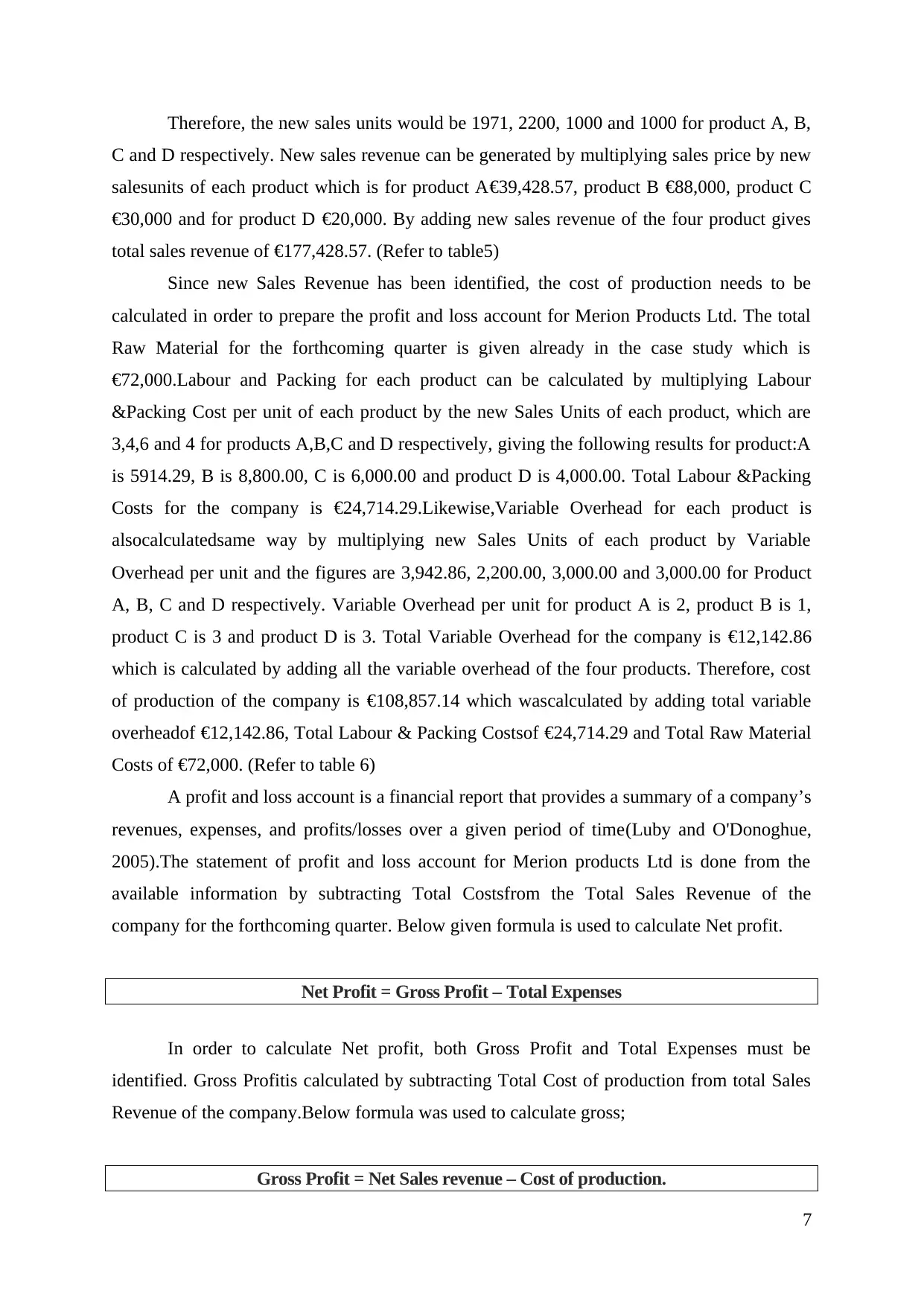
Therefore, the new sales units would be 1971, 2200, 1000 and 1000 for product A, B,
C and D respectively. New sales revenue can be generated by multiplying sales price by new
salesunits of each product which is for product A€39,428.57, product B €88,000, product C
€30,000 and for product D €20,000. By adding new sales revenue of the four product gives
total sales revenue of €177,428.57. (Refer to table5)
Since new Sales Revenue has been identified, the cost of production needs to be
calculated in order to prepare the profit and loss account for Merion Products Ltd. The total
Raw Material for the forthcoming quarter is given already in the case study which is
€72,000.Labour and Packing for each product can be calculated by multiplying Labour
&Packing Cost per unit of each product by the new Sales Units of each product, which are
3,4,6 and 4 for products A,B,C and D respectively, giving the following results for product:A
is 5914.29, B is 8,800.00, C is 6,000.00 and product D is 4,000.00. Total Labour &Packing
Costs for the company is €24,714.29.Likewise,Variable Overhead for each product is
alsocalculatedsame way by multiplying new Sales Units of each product by Variable
Overhead per unit and the figures are 3,942.86, 2,200.00, 3,000.00 and 3,000.00 for Product
A, B, C and D respectively. Variable Overhead per unit for product A is 2, product B is 1,
product C is 3 and product D is 3. Total Variable Overhead for the company is €12,142.86
which is calculated by adding all the variable overhead of the four products. Therefore, cost
of production of the company is €108,857.14 which wascalculated by adding total variable
overheadof €12,142.86, Total Labour & Packing Costsof €24,714.29 and Total Raw Material
Costs of €72,000. (Refer to table 6)
A profit and loss account is a financial report that provides a summary of a company’s
revenues, expenses, and profits/losses over a given period of time(Luby and O'Donoghue,
2005).The statement of profit and loss account for Merion products Ltd is done from the
available information by subtracting Total Costsfrom the Total Sales Revenue of the
company for the forthcoming quarter. Below given formula is used to calculate Net profit.
Net Profit = Gross Profit – Total Expenses
In order to calculate Net profit, both Gross Profit and Total Expenses must be
identified. Gross Profitis calculated by subtracting Total Cost of production from total Sales
Revenue of the company.Below formula was used to calculate gross;
Gross Profit = Net Sales revenue – Cost of production.
7
C and D respectively. New sales revenue can be generated by multiplying sales price by new
salesunits of each product which is for product A€39,428.57, product B €88,000, product C
€30,000 and for product D €20,000. By adding new sales revenue of the four product gives
total sales revenue of €177,428.57. (Refer to table5)
Since new Sales Revenue has been identified, the cost of production needs to be
calculated in order to prepare the profit and loss account for Merion Products Ltd. The total
Raw Material for the forthcoming quarter is given already in the case study which is
€72,000.Labour and Packing for each product can be calculated by multiplying Labour
&Packing Cost per unit of each product by the new Sales Units of each product, which are
3,4,6 and 4 for products A,B,C and D respectively, giving the following results for product:A
is 5914.29, B is 8,800.00, C is 6,000.00 and product D is 4,000.00. Total Labour &Packing
Costs for the company is €24,714.29.Likewise,Variable Overhead for each product is
alsocalculatedsame way by multiplying new Sales Units of each product by Variable
Overhead per unit and the figures are 3,942.86, 2,200.00, 3,000.00 and 3,000.00 for Product
A, B, C and D respectively. Variable Overhead per unit for product A is 2, product B is 1,
product C is 3 and product D is 3. Total Variable Overhead for the company is €12,142.86
which is calculated by adding all the variable overhead of the four products. Therefore, cost
of production of the company is €108,857.14 which wascalculated by adding total variable
overheadof €12,142.86, Total Labour & Packing Costsof €24,714.29 and Total Raw Material
Costs of €72,000. (Refer to table 6)
A profit and loss account is a financial report that provides a summary of a company’s
revenues, expenses, and profits/losses over a given period of time(Luby and O'Donoghue,
2005).The statement of profit and loss account for Merion products Ltd is done from the
available information by subtracting Total Costsfrom the Total Sales Revenue of the
company for the forthcoming quarter. Below given formula is used to calculate Net profit.
Net Profit = Gross Profit – Total Expenses
In order to calculate Net profit, both Gross Profit and Total Expenses must be
identified. Gross Profitis calculated by subtracting Total Cost of production from total Sales
Revenue of the company.Below formula was used to calculate gross;
Gross Profit = Net Sales revenue – Cost of production.
7
Paraphrase This Document
Need a fresh take? Get an instant paraphrase of this document with our AI Paraphraser
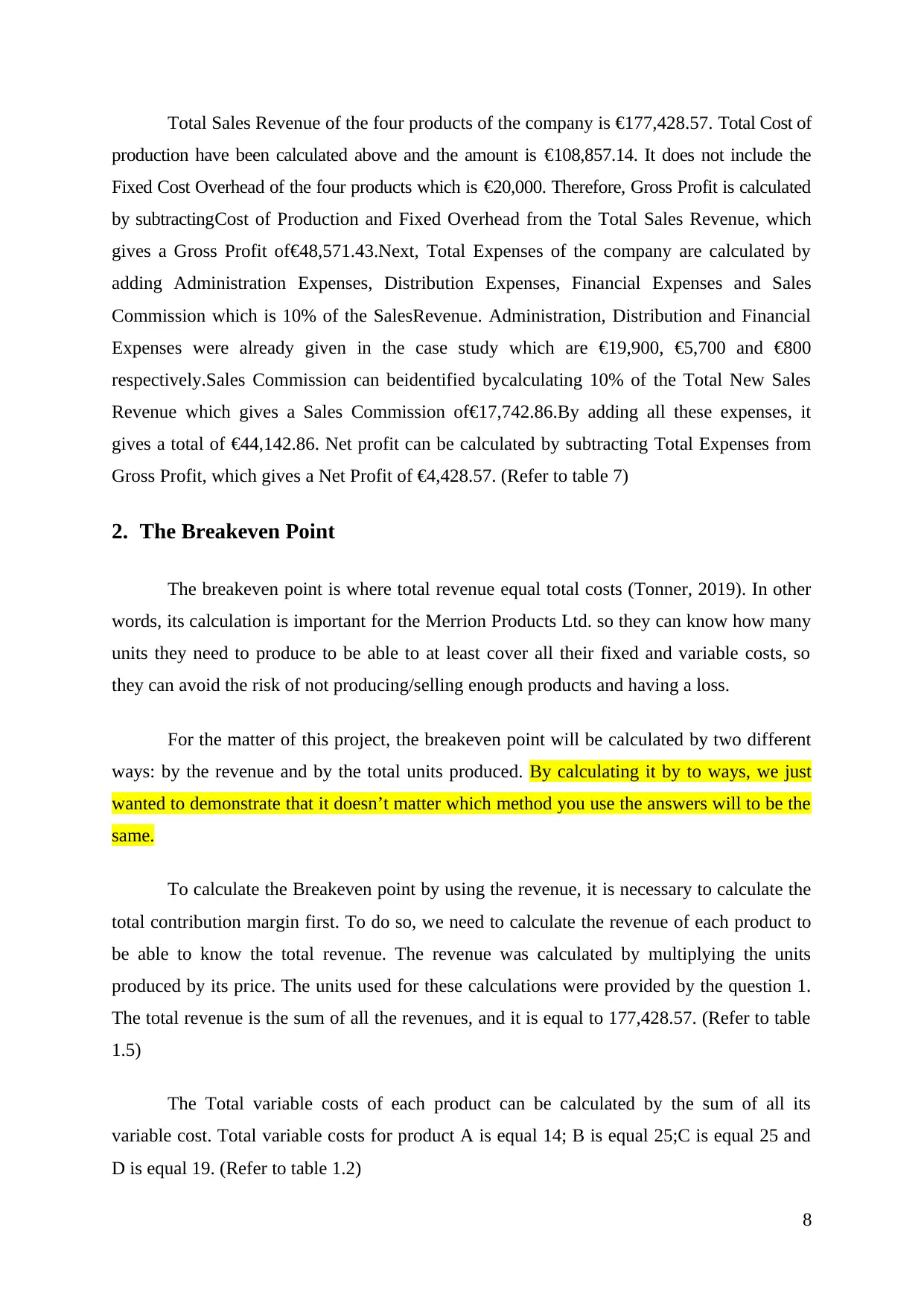
Total Sales Revenue of the four products of the company is €177,428.57. Total Cost of
production have been calculated above and the amount is €108,857.14. It does not include the
Fixed Cost Overhead of the four products which is €20,000. Therefore, Gross Profit is calculated
by subtractingCost of Production and Fixed Overhead from the Total Sales Revenue, which
gives a Gross Profit of€48,571.43.Next, Total Expenses of the company are calculated by
adding Administration Expenses, Distribution Expenses, Financial Expenses and Sales
Commission which is 10% of the SalesRevenue. Administration, Distribution and Financial
Expenses were already given in the case study which are €19,900, €5,700 and €800
respectively.Sales Commission can beidentified bycalculating 10% of the Total New Sales
Revenue which gives a Sales Commission of€17,742.86.By adding all these expenses, it
gives a total of €44,142.86. Net profit can be calculated by subtracting Total Expenses from
Gross Profit, which gives a Net Profit of €4,428.57. (Refer to table 7)
2. The Breakeven Point
The breakeven point is where total revenue equal total costs (Tonner, 2019). In other
words, its calculation is important for the Merrion Products Ltd. so they can know how many
units they need to produce to be able to at least cover all their fixed and variable costs, so
they can avoid the risk of not producing/selling enough products and having a loss.
For the matter of this project, the breakeven point will be calculated by two different
ways: by the revenue and by the total units produced. By calculating it by to ways, we just
wanted to demonstrate that it doesn’t matter which method you use the answers will to be the
same.
To calculate the Breakeven point by using the revenue, it is necessary to calculate the
total contribution margin first. To do so, we need to calculate the revenue of each product to
be able to know the total revenue. The revenue was calculated by multiplying the units
produced by its price. The units used for these calculations were provided by the question 1.
The total revenue is the sum of all the revenues, and it is equal to 177,428.57. (Refer to table
1.5)
The Total variable costs of each product can be calculated by the sum of all its
variable cost. Total variable costs for product A is equal 14; B is equal 25;C is equal 25 and
D is equal 19. (Refer to table 1.2)
8
production have been calculated above and the amount is €108,857.14. It does not include the
Fixed Cost Overhead of the four products which is €20,000. Therefore, Gross Profit is calculated
by subtractingCost of Production and Fixed Overhead from the Total Sales Revenue, which
gives a Gross Profit of€48,571.43.Next, Total Expenses of the company are calculated by
adding Administration Expenses, Distribution Expenses, Financial Expenses and Sales
Commission which is 10% of the SalesRevenue. Administration, Distribution and Financial
Expenses were already given in the case study which are €19,900, €5,700 and €800
respectively.Sales Commission can beidentified bycalculating 10% of the Total New Sales
Revenue which gives a Sales Commission of€17,742.86.By adding all these expenses, it
gives a total of €44,142.86. Net profit can be calculated by subtracting Total Expenses from
Gross Profit, which gives a Net Profit of €4,428.57. (Refer to table 7)
2. The Breakeven Point
The breakeven point is where total revenue equal total costs (Tonner, 2019). In other
words, its calculation is important for the Merrion Products Ltd. so they can know how many
units they need to produce to be able to at least cover all their fixed and variable costs, so
they can avoid the risk of not producing/selling enough products and having a loss.
For the matter of this project, the breakeven point will be calculated by two different
ways: by the revenue and by the total units produced. By calculating it by to ways, we just
wanted to demonstrate that it doesn’t matter which method you use the answers will to be the
same.
To calculate the Breakeven point by using the revenue, it is necessary to calculate the
total contribution margin first. To do so, we need to calculate the revenue of each product to
be able to know the total revenue. The revenue was calculated by multiplying the units
produced by its price. The units used for these calculations were provided by the question 1.
The total revenue is the sum of all the revenues, and it is equal to 177,428.57. (Refer to table
1.5)
The Total variable costs of each product can be calculated by the sum of all its
variable cost. Total variable costs for product A is equal 14; B is equal 25;C is equal 25 and
D is equal 19. (Refer to table 1.2)
8
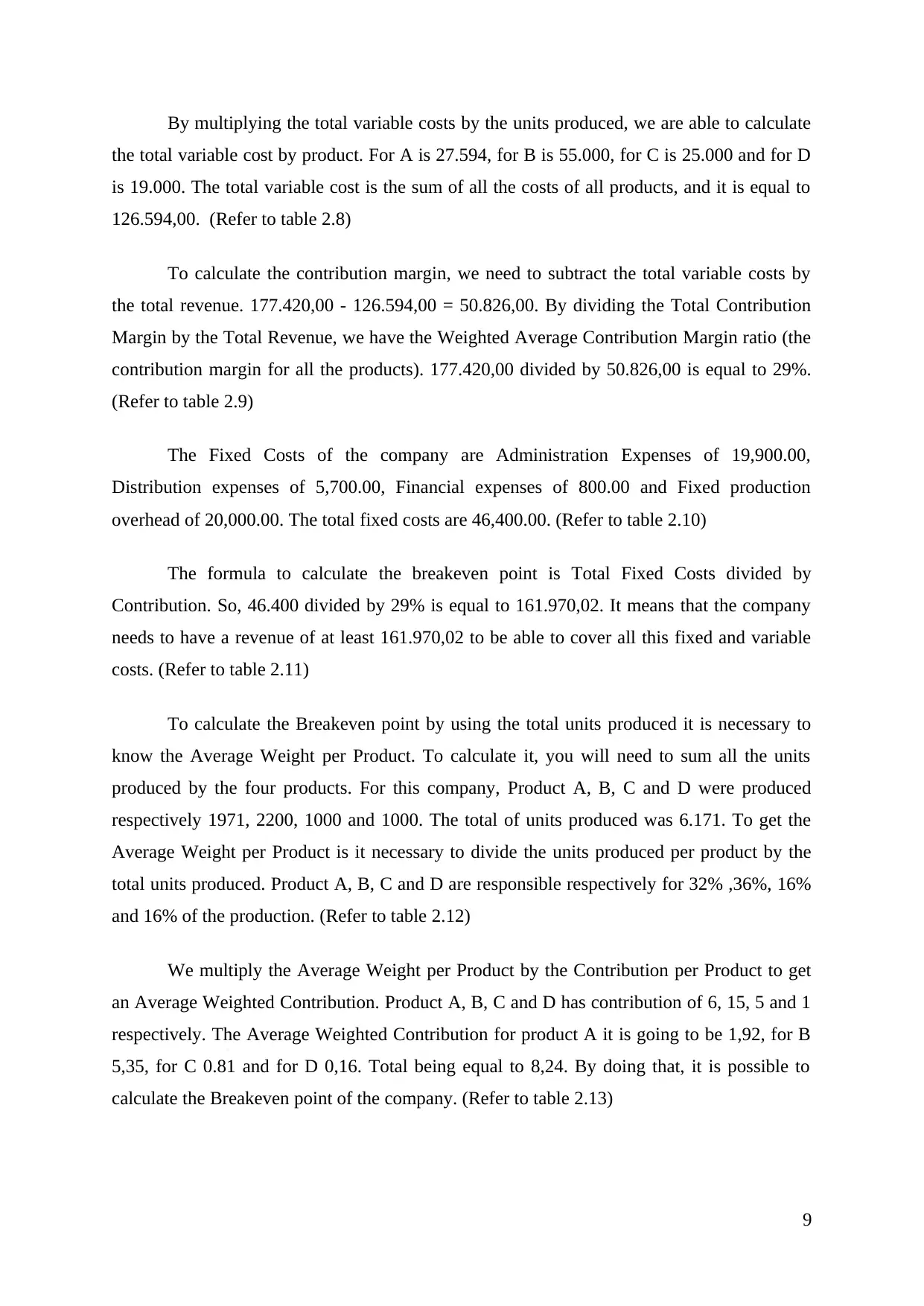
By multiplying the total variable costs by the units produced, we are able to calculate
the total variable cost by product. For A is 27.594, for B is 55.000, for C is 25.000 and for D
is 19.000. The total variable cost is the sum of all the costs of all products, and it is equal to
126.594,00. (Refer to table 2.8)
To calculate the contribution margin, we need to subtract the total variable costs by
the total revenue. 177.420,00 - 126.594,00 = 50.826,00. By dividing the Total Contribution
Margin by the Total Revenue, we have the Weighted Average Contribution Margin ratio (the
contribution margin for all the products). 177.420,00 divided by 50.826,00 is equal to 29%.
(Refer to table 2.9)
The Fixed Costs of the company are Administration Expenses of 19,900.00,
Distribution expenses of 5,700.00, Financial expenses of 800.00 and Fixed production
overhead of 20,000.00. The total fixed costs are 46,400.00. (Refer to table 2.10)
The formula to calculate the breakeven point is Total Fixed Costs divided by
Contribution. So, 46.400 divided by 29% is equal to 161.970,02. It means that the company
needs to have a revenue of at least 161.970,02 to be able to cover all this fixed and variable
costs. (Refer to table 2.11)
To calculate the Breakeven point by using the total units produced it is necessary to
know the Average Weight per Product. To calculate it, you will need to sum all the units
produced by the four products. For this company, Product A, B, C and D were produced
respectively 1971, 2200, 1000 and 1000. The total of units produced was 6.171. To get the
Average Weight per Product is it necessary to divide the units produced per product by the
total units produced. Product A, B, C and D are responsible respectively for 32% ,36%, 16%
and 16% of the production. (Refer to table 2.12)
We multiply the Average Weight per Product by the Contribution per Product to get
an Average Weighted Contribution. Product A, B, C and D has contribution of 6, 15, 5 and 1
respectively. The Average Weighted Contribution for product A it is going to be 1,92, for B
5,35, for C 0.81 and for D 0,16. Total being equal to 8,24. By doing that, it is possible to
calculate the Breakeven point of the company. (Refer to table 2.13)
9
the total variable cost by product. For A is 27.594, for B is 55.000, for C is 25.000 and for D
is 19.000. The total variable cost is the sum of all the costs of all products, and it is equal to
126.594,00. (Refer to table 2.8)
To calculate the contribution margin, we need to subtract the total variable costs by
the total revenue. 177.420,00 - 126.594,00 = 50.826,00. By dividing the Total Contribution
Margin by the Total Revenue, we have the Weighted Average Contribution Margin ratio (the
contribution margin for all the products). 177.420,00 divided by 50.826,00 is equal to 29%.
(Refer to table 2.9)
The Fixed Costs of the company are Administration Expenses of 19,900.00,
Distribution expenses of 5,700.00, Financial expenses of 800.00 and Fixed production
overhead of 20,000.00. The total fixed costs are 46,400.00. (Refer to table 2.10)
The formula to calculate the breakeven point is Total Fixed Costs divided by
Contribution. So, 46.400 divided by 29% is equal to 161.970,02. It means that the company
needs to have a revenue of at least 161.970,02 to be able to cover all this fixed and variable
costs. (Refer to table 2.11)
To calculate the Breakeven point by using the total units produced it is necessary to
know the Average Weight per Product. To calculate it, you will need to sum all the units
produced by the four products. For this company, Product A, B, C and D were produced
respectively 1971, 2200, 1000 and 1000. The total of units produced was 6.171. To get the
Average Weight per Product is it necessary to divide the units produced per product by the
total units produced. Product A, B, C and D are responsible respectively for 32% ,36%, 16%
and 16% of the production. (Refer to table 2.12)
We multiply the Average Weight per Product by the Contribution per Product to get
an Average Weighted Contribution. Product A, B, C and D has contribution of 6, 15, 5 and 1
respectively. The Average Weighted Contribution for product A it is going to be 1,92, for B
5,35, for C 0.81 and for D 0,16. Total being equal to 8,24. By doing that, it is possible to
calculate the Breakeven point of the company. (Refer to table 2.13)
9
⊘ This is a preview!⊘
Do you want full access?
Subscribe today to unlock all pages.

Trusted by 1+ million students worldwide
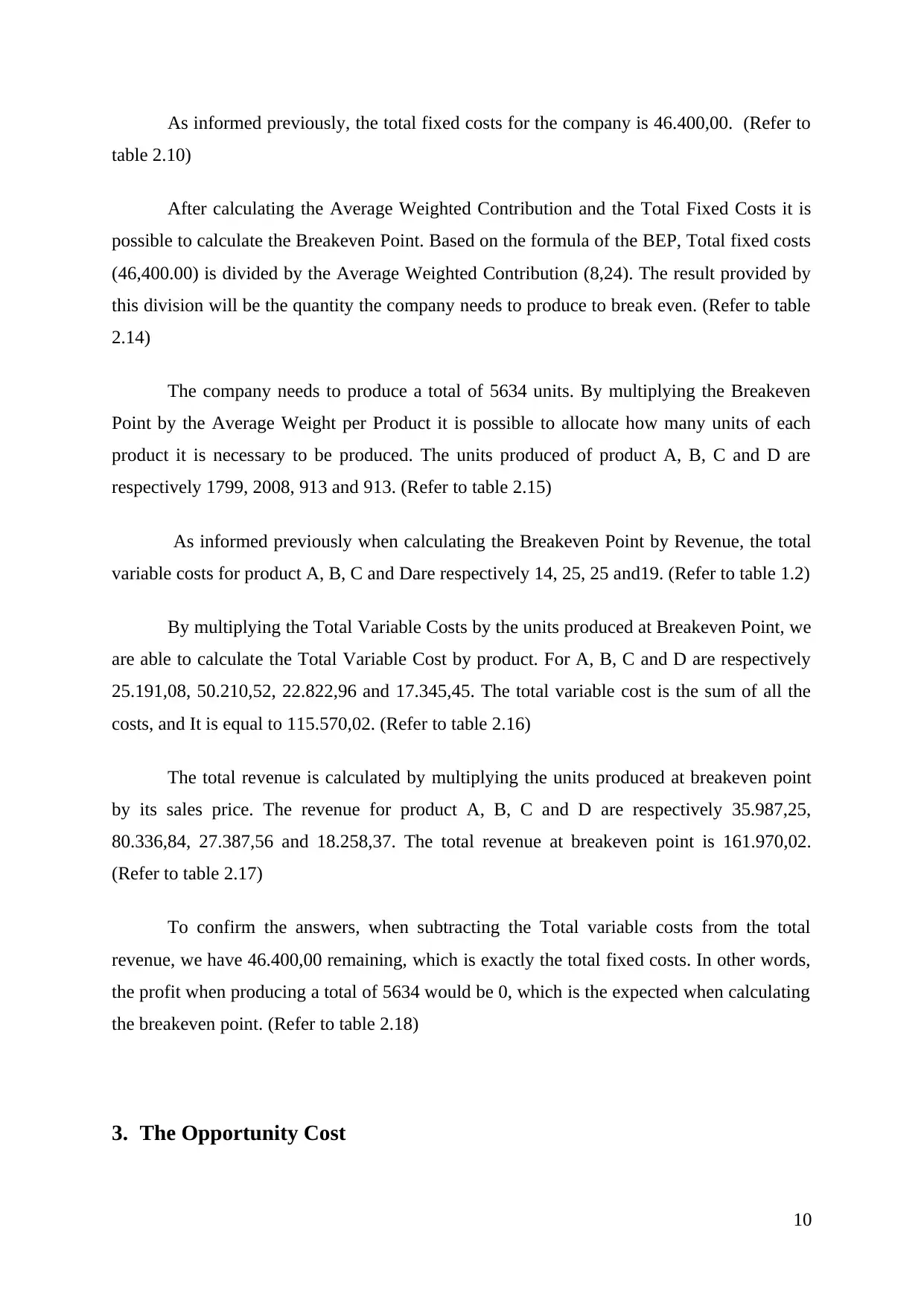
As informed previously, the total fixed costs for the company is 46.400,00. (Refer to
table 2.10)
After calculating the Average Weighted Contribution and the Total Fixed Costs it is
possible to calculate the Breakeven Point. Based on the formula of the BEP, Total fixed costs
(46,400.00) is divided by the Average Weighted Contribution (8,24). The result provided by
this division will be the quantity the company needs to produce to break even. (Refer to table
2.14)
The company needs to produce a total of 5634 units. By multiplying the Breakeven
Point by the Average Weight per Product it is possible to allocate how many units of each
product it is necessary to be produced. The units produced of product A, B, C and D are
respectively 1799, 2008, 913 and 913. (Refer to table 2.15)
As informed previously when calculating the Breakeven Point by Revenue, the total
variable costs for product A, B, C and Dare respectively 14, 25, 25 and19. (Refer to table 1.2)
By multiplying the Total Variable Costs by the units produced at Breakeven Point, we
are able to calculate the Total Variable Cost by product. For A, B, C and D are respectively
25.191,08, 50.210,52, 22.822,96 and 17.345,45. The total variable cost is the sum of all the
costs, and It is equal to 115.570,02. (Refer to table 2.16)
The total revenue is calculated by multiplying the units produced at breakeven point
by its sales price. The revenue for product A, B, C and D are respectively 35.987,25,
80.336,84, 27.387,56 and 18.258,37. The total revenue at breakeven point is 161.970,02.
(Refer to table 2.17)
To confirm the answers, when subtracting the Total variable costs from the total
revenue, we have 46.400,00 remaining, which is exactly the total fixed costs. In other words,
the profit when producing a total of 5634 would be 0, which is the expected when calculating
the breakeven point. (Refer to table 2.18)
3. The Opportunity Cost
10
table 2.10)
After calculating the Average Weighted Contribution and the Total Fixed Costs it is
possible to calculate the Breakeven Point. Based on the formula of the BEP, Total fixed costs
(46,400.00) is divided by the Average Weighted Contribution (8,24). The result provided by
this division will be the quantity the company needs to produce to break even. (Refer to table
2.14)
The company needs to produce a total of 5634 units. By multiplying the Breakeven
Point by the Average Weight per Product it is possible to allocate how many units of each
product it is necessary to be produced. The units produced of product A, B, C and D are
respectively 1799, 2008, 913 and 913. (Refer to table 2.15)
As informed previously when calculating the Breakeven Point by Revenue, the total
variable costs for product A, B, C and Dare respectively 14, 25, 25 and19. (Refer to table 1.2)
By multiplying the Total Variable Costs by the units produced at Breakeven Point, we
are able to calculate the Total Variable Cost by product. For A, B, C and D are respectively
25.191,08, 50.210,52, 22.822,96 and 17.345,45. The total variable cost is the sum of all the
costs, and It is equal to 115.570,02. (Refer to table 2.16)
The total revenue is calculated by multiplying the units produced at breakeven point
by its sales price. The revenue for product A, B, C and D are respectively 35.987,25,
80.336,84, 27.387,56 and 18.258,37. The total revenue at breakeven point is 161.970,02.
(Refer to table 2.17)
To confirm the answers, when subtracting the Total variable costs from the total
revenue, we have 46.400,00 remaining, which is exactly the total fixed costs. In other words,
the profit when producing a total of 5634 would be 0, which is the expected when calculating
the breakeven point. (Refer to table 2.18)
3. The Opportunity Cost
10
Paraphrase This Document
Need a fresh take? Get an instant paraphrase of this document with our AI Paraphraser
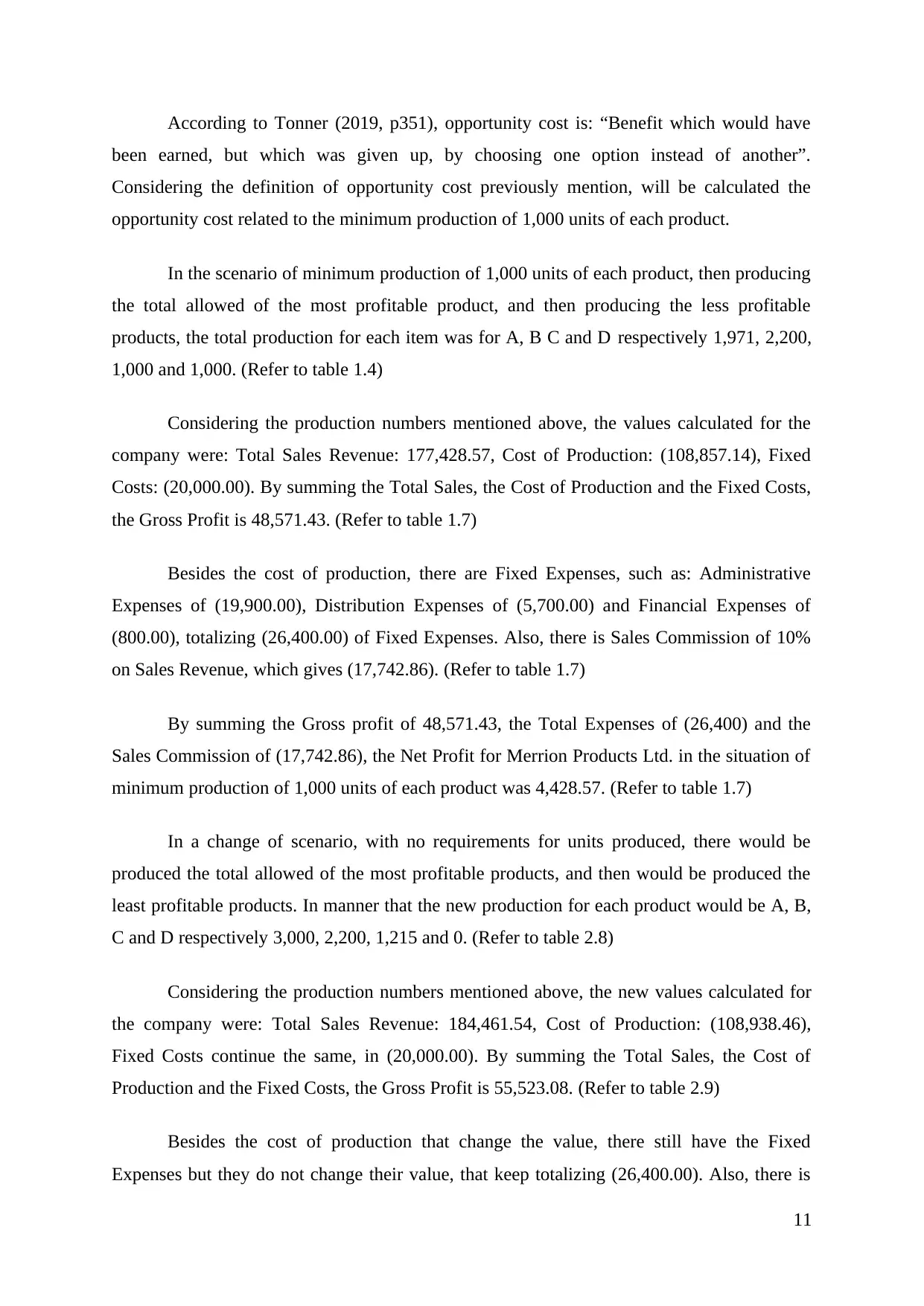
According to Tonner (2019, p351), opportunity cost is: “Benefit which would have
been earned, but which was given up, by choosing one option instead of another”.
Considering the definition of opportunity cost previously mention, will be calculated the
opportunity cost related to the minimum production of 1,000 units of each product.
In the scenario of minimum production of 1,000 units of each product, then producing
the total allowed of the most profitable product, and then producing the less profitable
products, the total production for each item was for A, B C and D respectively 1,971, 2,200,
1,000 and 1,000. (Refer to table 1.4)
Considering the production numbers mentioned above, the values calculated for the
company were: Total Sales Revenue: 177,428.57, Cost of Production: (108,857.14), Fixed
Costs: (20,000.00). By summing the Total Sales, the Cost of Production and the Fixed Costs,
the Gross Profit is 48,571.43. (Refer to table 1.7)
Besides the cost of production, there are Fixed Expenses, such as: Administrative
Expenses of (19,900.00), Distribution Expenses of (5,700.00) and Financial Expenses of
(800.00), totalizing (26,400.00) of Fixed Expenses. Also, there is Sales Commission of 10%
on Sales Revenue, which gives (17,742.86). (Refer to table 1.7)
By summing the Gross profit of 48,571.43, the Total Expenses of (26,400) and the
Sales Commission of (17,742.86), the Net Profit for Merrion Products Ltd. in the situation of
minimum production of 1,000 units of each product was 4,428.57. (Refer to table 1.7)
In a change of scenario, with no requirements for units produced, there would be
produced the total allowed of the most profitable products, and then would be produced the
least profitable products. In manner that the new production for each product would be A, B,
C and D respectively 3,000, 2,200, 1,215 and 0. (Refer to table 2.8)
Considering the production numbers mentioned above, the new values calculated for
the company were: Total Sales Revenue: 184,461.54, Cost of Production: (108,938.46),
Fixed Costs continue the same, in (20,000.00). By summing the Total Sales, the Cost of
Production and the Fixed Costs, the Gross Profit is 55,523.08. (Refer to table 2.9)
Besides the cost of production that change the value, there still have the Fixed
Expenses but they do not change their value, that keep totalizing (26,400.00). Also, there is
11
been earned, but which was given up, by choosing one option instead of another”.
Considering the definition of opportunity cost previously mention, will be calculated the
opportunity cost related to the minimum production of 1,000 units of each product.
In the scenario of minimum production of 1,000 units of each product, then producing
the total allowed of the most profitable product, and then producing the less profitable
products, the total production for each item was for A, B C and D respectively 1,971, 2,200,
1,000 and 1,000. (Refer to table 1.4)
Considering the production numbers mentioned above, the values calculated for the
company were: Total Sales Revenue: 177,428.57, Cost of Production: (108,857.14), Fixed
Costs: (20,000.00). By summing the Total Sales, the Cost of Production and the Fixed Costs,
the Gross Profit is 48,571.43. (Refer to table 1.7)
Besides the cost of production, there are Fixed Expenses, such as: Administrative
Expenses of (19,900.00), Distribution Expenses of (5,700.00) and Financial Expenses of
(800.00), totalizing (26,400.00) of Fixed Expenses. Also, there is Sales Commission of 10%
on Sales Revenue, which gives (17,742.86). (Refer to table 1.7)
By summing the Gross profit of 48,571.43, the Total Expenses of (26,400) and the
Sales Commission of (17,742.86), the Net Profit for Merrion Products Ltd. in the situation of
minimum production of 1,000 units of each product was 4,428.57. (Refer to table 1.7)
In a change of scenario, with no requirements for units produced, there would be
produced the total allowed of the most profitable products, and then would be produced the
least profitable products. In manner that the new production for each product would be A, B,
C and D respectively 3,000, 2,200, 1,215 and 0. (Refer to table 2.8)
Considering the production numbers mentioned above, the new values calculated for
the company were: Total Sales Revenue: 184,461.54, Cost of Production: (108,938.46),
Fixed Costs continue the same, in (20,000.00). By summing the Total Sales, the Cost of
Production and the Fixed Costs, the Gross Profit is 55,523.08. (Refer to table 2.9)
Besides the cost of production that change the value, there still have the Fixed
Expenses but they do not change their value, that keep totalizing (26,400.00). Also, there is
11
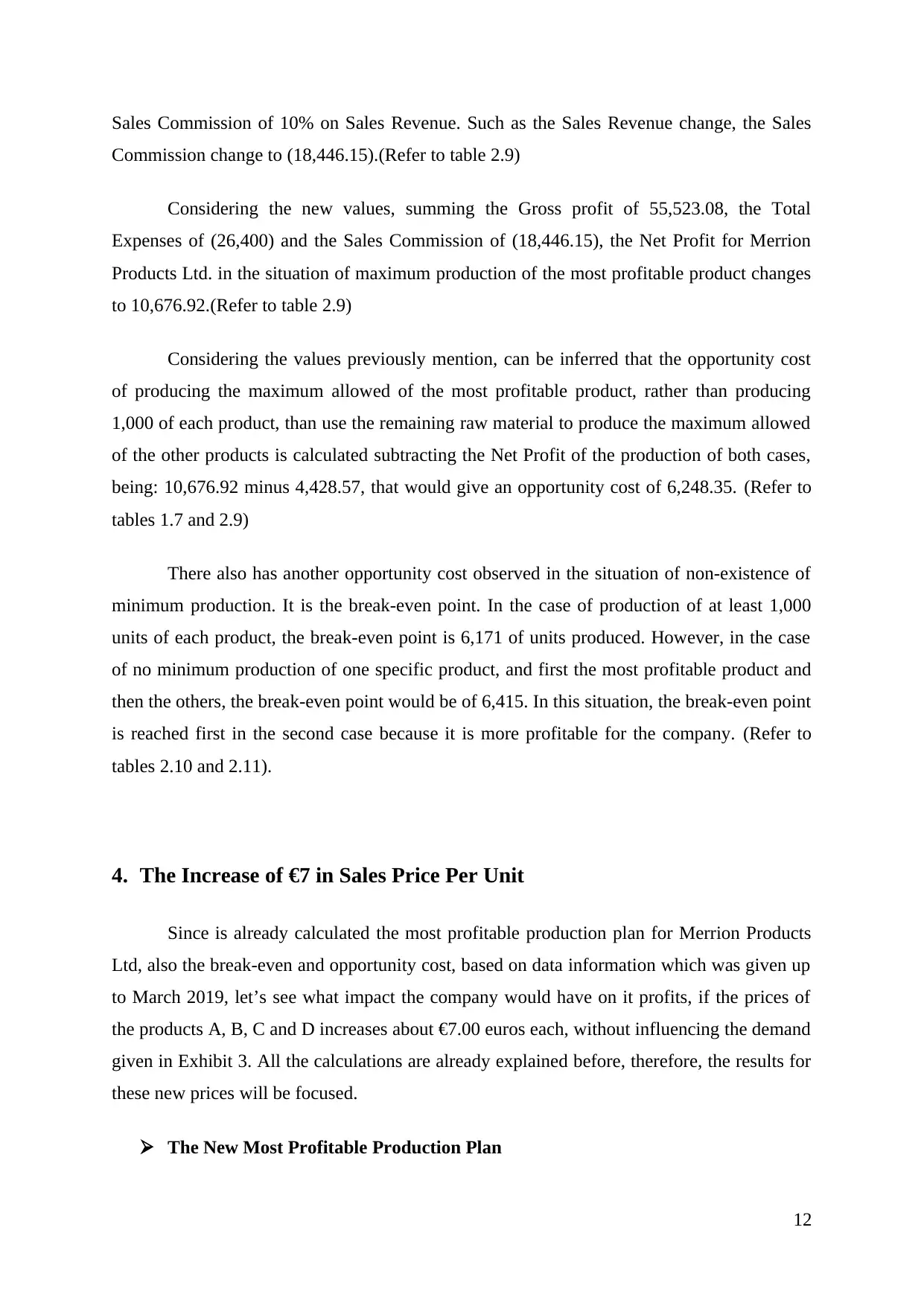
Sales Commission of 10% on Sales Revenue. Such as the Sales Revenue change, the Sales
Commission change to (18,446.15).(Refer to table 2.9)
Considering the new values, summing the Gross profit of 55,523.08, the Total
Expenses of (26,400) and the Sales Commission of (18,446.15), the Net Profit for Merrion
Products Ltd. in the situation of maximum production of the most profitable product changes
to 10,676.92.(Refer to table 2.9)
Considering the values previously mention, can be inferred that the opportunity cost
of producing the maximum allowed of the most profitable product, rather than producing
1,000 of each product, than use the remaining raw material to produce the maximum allowed
of the other products is calculated subtracting the Net Profit of the production of both cases,
being: 10,676.92 minus 4,428.57, that would give an opportunity cost of 6,248.35. (Refer to
tables 1.7 and 2.9)
There also has another opportunity cost observed in the situation of non-existence of
minimum production. It is the break-even point. In the case of production of at least 1,000
units of each product, the break-even point is 6,171 of units produced. However, in the case
of no minimum production of one specific product, and first the most profitable product and
then the others, the break-even point would be of 6,415. In this situation, the break-even point
is reached first in the second case because it is more profitable for the company. (Refer to
tables 2.10 and 2.11).
4. The Increase of €7 in Sales Price Per Unit
Since is already calculated the most profitable production plan for Merrion Products
Ltd, also the break-even and opportunity cost, based on data information which was given up
to March 2019, let’s see what impact the company would have on it profits, if the prices of
the products A, B, C and D increases about €7.00 euros each, without influencing the demand
given in Exhibit 3. All the calculations are already explained before, therefore, the results for
these new prices will be focused.
The New Most Profitable Production Plan
12
Commission change to (18,446.15).(Refer to table 2.9)
Considering the new values, summing the Gross profit of 55,523.08, the Total
Expenses of (26,400) and the Sales Commission of (18,446.15), the Net Profit for Merrion
Products Ltd. in the situation of maximum production of the most profitable product changes
to 10,676.92.(Refer to table 2.9)
Considering the values previously mention, can be inferred that the opportunity cost
of producing the maximum allowed of the most profitable product, rather than producing
1,000 of each product, than use the remaining raw material to produce the maximum allowed
of the other products is calculated subtracting the Net Profit of the production of both cases,
being: 10,676.92 minus 4,428.57, that would give an opportunity cost of 6,248.35. (Refer to
tables 1.7 and 2.9)
There also has another opportunity cost observed in the situation of non-existence of
minimum production. It is the break-even point. In the case of production of at least 1,000
units of each product, the break-even point is 6,171 of units produced. However, in the case
of no minimum production of one specific product, and first the most profitable product and
then the others, the break-even point would be of 6,415. In this situation, the break-even point
is reached first in the second case because it is more profitable for the company. (Refer to
tables 2.10 and 2.11).
4. The Increase of €7 in Sales Price Per Unit
Since is already calculated the most profitable production plan for Merrion Products
Ltd, also the break-even and opportunity cost, based on data information which was given up
to March 2019, let’s see what impact the company would have on it profits, if the prices of
the products A, B, C and D increases about €7.00 euros each, without influencing the demand
given in Exhibit 3. All the calculations are already explained before, therefore, the results for
these new prices will be focused.
The New Most Profitable Production Plan
12
⊘ This is a preview!⊘
Do you want full access?
Subscribe today to unlock all pages.

Trusted by 1+ million students worldwide
1 out of 24
Related Documents
Your All-in-One AI-Powered Toolkit for Academic Success.
+13062052269
info@desklib.com
Available 24*7 on WhatsApp / Email
![[object Object]](/_next/static/media/star-bottom.7253800d.svg)
Unlock your academic potential
Copyright © 2020–2025 A2Z Services. All Rights Reserved. Developed and managed by ZUCOL.





